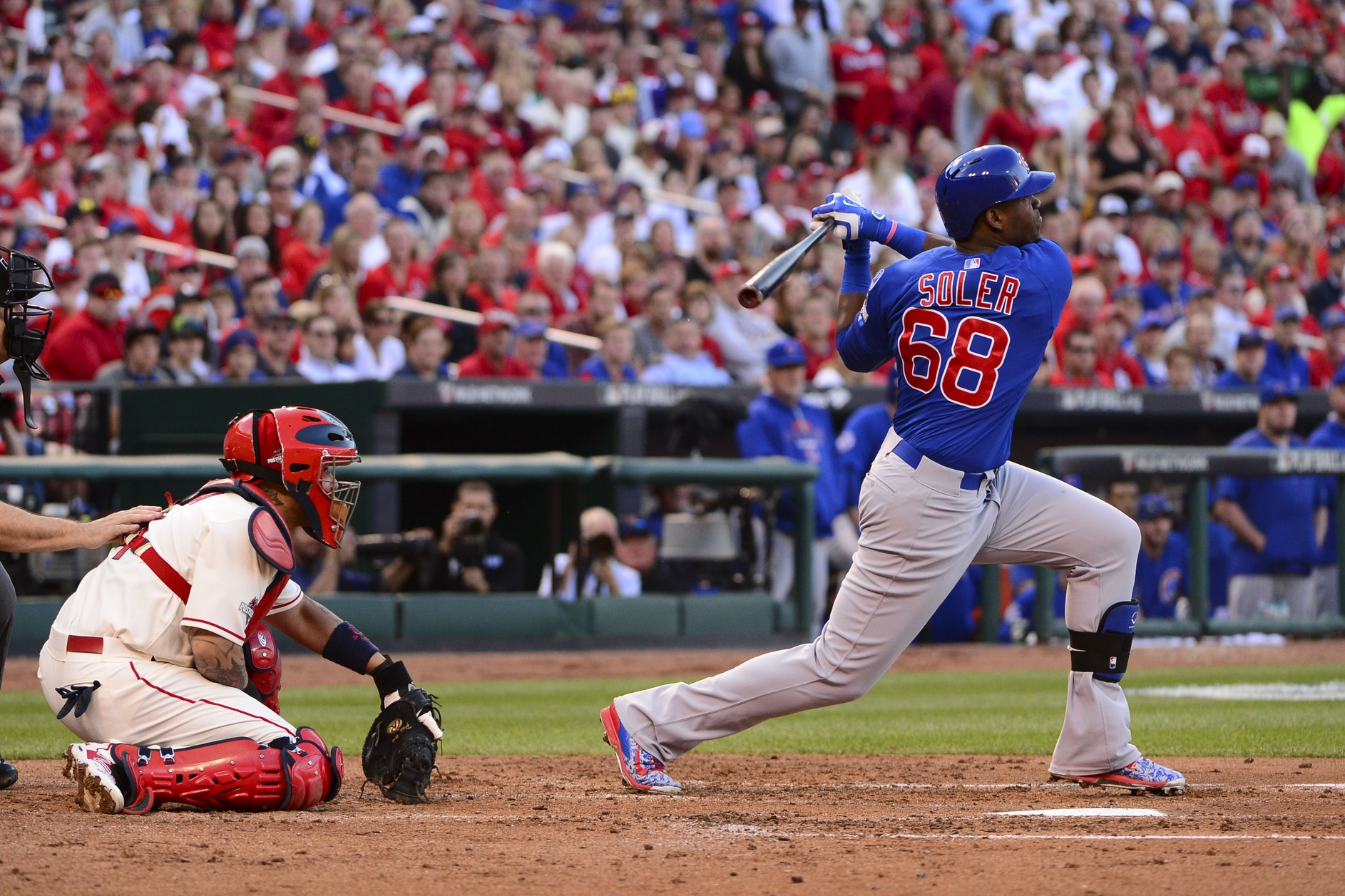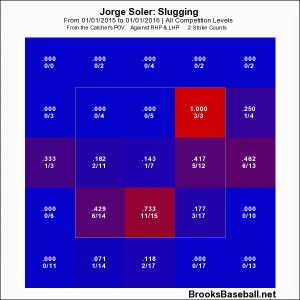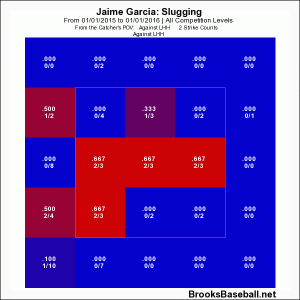Welcome to the postseason, Señor!
-Brian Anderson, on the home run call
The results of inserting Jorge Soler into the two hole against Jaime Garcia in Game Two were overwhelmingly positive. The decision, however, was curious, just slightly, based on Soler’s peripherals in 2015.
First, in 71 plate appearances from the two-hole, about 17 percent of his plate appearances, Soler hit .269/.296/.403 with just one home run and 4.2 percent walk rate. He produced little power or ability to get on base from that spot in the order, but it was a small sample size.
Secondly, Soler’s production against left-handed pitching (.268/.311/.409, 31.5 percent strikeout rate) was actually worse than his production against right-handed pitchers. And in 2015, Jaime Garcia held right handed batters to just .218/.266/.292. While Soler and Garcia had never faced each other previously, Soler had struggled against left-handers with Garcia’s repertoire. In 2015, against left handers, Soler had done almost the entirety of his damage on four-seam fastballs, which only accounted for 26 percent of Garcia’s pitches to right-handed batters. Against the four other pitches that comprised the other 74 percent of Garcia’s 2015, Soler struggled mightily:
| Pitch | AVG | SLP | K | HR |
| Fourseam | .412 | .647 | 5 | 1 |
| Sinker | .313 | .375 | 3 | 0 |
| Change | .177 | .412 | 6 | 1 |
| Slider | .000 | .000 | 9 | 0 |
| Curve | .222 | .222 | 4 | 0 |
What did stand out, though, is that eight of his 10 home runs came against left-handed pitchers. With Bryant and Rizzo scuffling, the Cubs needed pop against Garcia at the top of the lineup. Additionally, Garcia tends to remain around the strike zone, thus increasing the chances of Soler running into a few pitches left over the plate.
In Soler’s first at-bat, Garcia started him with a 91-mph four-seam fastball for a called first strike. While Soler did most his damage against left-handed pitchers on the four-seam fastball, as you saw above, he swung at just 11.4 percent of first pitches. Knowing this, Garcia and Yadier Molina stole a first-pitch strike, aware that once pitchers got ahead of Soler 0-1 this season, he hit just .204/.260/.306. Garcia would show Soler his four-seam curve, slider, change, and despite Soler falling behind early, he pulled a 3-2 breaking ball on the inner half of the plate down the left-field line for a double. It was Soler’s first extra-base hit off a curve in 2015.
Soler came to the plate with two outs and Dexter Fowler on first base. This time, Garcia started Soler with two breaking pitches that missed, and he fell behind 2-0. Garcia would even the count at 2-2, and came with a breaking pitch down and in that Soler managed to fight off. Another 2-2 pitch would follow.
How did Soler and Garcia perform this season once the count reached 2-and-2?
Soler on 2-and-2 this season…
.123/.134/.154, 0 HR, 0.0 percent walk rate, 49.3 percent strikeout rate
The nearly 50 percent strikeout rate on 2-2 is not huge surprise for Soler, who posted a 30 percent strikeout rate overall on the season. And as a TBS graphic flashed during the game, Soler’s .124 AVG with two strikes was the fifth lowest in the NL. When pitchers got to two strikes against Soler, they found success going low and away, up and in, and down and in:
However, Soler’s first-inning double had come on a pitch in that bottom inside part of the plate. Entering the game, he had also found some success in the middle of the strike zone and away. File that away.
Garcia on 2-and-2 this season…
.138/.138/.154, 0 HR, 0.0 percent walk rate, 38.5 percent strikeout rate.
With two strikes, Garcia went to his two breaking pitches 49 percent of the time. In Soler’s first at-bat, he tried a two-strike curve, which Soler roped down the left-field line.
When Garcia got to two strikes against left-handed batters this season, he found success when he stayed away from the middle part of the strike zone:
When he came up in the middle third of the strike zone, though, right-handers had some success. Again, file that away.
The Pitch
With a second 2-2 pitch, Molina set up with his glove off the plate, before moving it back towards the strike zone. Remember above when we told you to file away Soler’s success spots with two strikes against left-handed pitchers? Well, the breaking ball would be in that outer half of the middle third of the strike zone, where Soler is able to get his bat head on the ball. He did just that and launched the ball 400 feet.
It was Soler’s first home run of the season on a 2-2 count. It was also Garcia’s first home run of the season allowed on a 2-2 count. Soler’s blast would give the Cubs a 5-1 lead, and with the Cardinals adding two more runs, would prove to be the difference in the game.
After the two-strike breaking pitch in his first at-bat, was Soler looking there again? It was a good bet, not just because of the first at-bat, but, as we mentioned above, Garcia goes to his breaking pitches nearly half of all strike-two counts against left-handed batters.
Soler has many holes in his swing with two strikes, but in his first tw0 at-bats, Garcia went to two spots where Soler had success this season. Joe Maddon’s move, as they have been so often this season, paid major dividends. That’s why he’s the manager of a team heading home tied 1-1 in the NLDS, and I am finishing a blog post about said move at 3 am.
Lead photo courtesy of Jeff Curry-USA TODAY Sports


